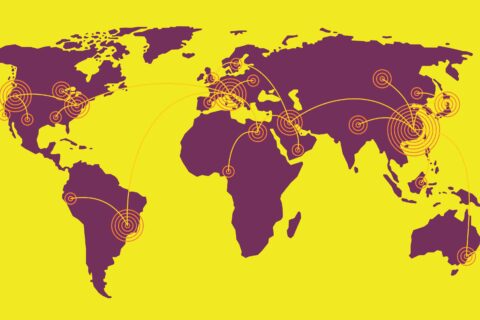Phase 1 – Keep Calm and Stay Home
On March 16, Delvinia implemented our business continuity plan, immediately moving all of our staff to working from home. In that first week our top priority was to keep our employees safe and calm, and to maintain service for our clients without interruptions. We have thankfully been successful in doing so, though it is something we must continue to monitor and work on to ensure we remain stable. With our stability, however, we felt a strong responsibility to give back, to provide some support during this crisis.
Phase 2 – Retool and Take Action
Feeling that responsibility, we created our COVID-19 Resource Hub. It houses all the initiatives we have been working on, partnering on, or supporting. There are weekly updates from our partners at PersonaPanels titled, Using AI to Identify Interest Trends of Coronavirus with Millennials. There is a video series asking top marketing leaders 3 questions in 3 minutes on how they are navigating these changing times. There are research reports and blog posts. We are offering all of these for free, doing what small part we can to contribute to the fight against coronavirus.
Phase 3 – Re-imagine the Future
Now we are beginning to look ahead. The benefits in long-term thinking are many. Yes, the world continues to change rapidly, but those who are preparing for the next wave are better able to ride it. This is most clearly evidenced by those companies who had already begun their digital transformations prior to the COVID-19 outbreak. Where technological infrastructure was already in place, companies were better able to adapt to this new virtual world. This pandemic has also forced consumers and companies alike to rapidly adopt technology where they may not have been previously comfortable. According to a recent study from Econsultancy and Marketing Week, 20% of large enterprises have either increased their spending or invested in new spending around digital transformation in 2020. And we can see why. Mobile ordering has gone up. Click and collect has become essential for grocery shoppers. Virtual events have become the norm. Businesses are able to continue, even if it is far from “business as usual”, thanks to digital tools.
So how do we take this digital transformation of our entire world and make it work for us in the future? How do we prepare for what feels like an unknowable future? For us, the answer is in the data. We must keep up with the ever-changing needs, wants, and behaviours of our target audiences in order to be prepared for the next stage of our world. We need to harness this adoption of technology to help us get better data, at the speed we require it. We must utilize new technologies to give us insights in new kinds of ways.
Automation will become critical, as researchers and insights professionals are asked for more information with less time to deliver it in. Their time will need to be spent analyzing the results rather than in the fielding of the project if their organization is going to stay ahead of the curve.
Virtual qualitative research will be incredibly important in gaining a nuanced and in-depth understanding of consumers. Online focus groups and virtual chatbot moderators will help facilitate this, and with participants’ increased use of digital tools in their daily lives, this will not be an uncomfortable experience.
In times of crisis it can be difficult to look beyond making it through each individual moment. We fall into being reactive rather than proactive, as it seems that is what is being demanded. However, technology is allowing us to move beyond that now. We are able to do things in new ways, or to simply do new things we never considered before.
Digital transformation is no longer a luxury for organizations, it is a requirement for survival today and into the future. This includes using technology to gather the data that is critically required to keep up with and even ahead of rapidly changing consumer behaviours and sentiments. The time to look forward is now, and we can’t do it without technology and data.


